
As the pork sector and related industries have their eyes on the African swine fever (ASF) situation, it could be particularly catastrophic if the disease were to heavily hit in China.
Steve Meyer, economist, Kerns & Associates, told attendees at the 2019 Annual Meat Conference in Dallas, Texas, that it would not only be disastrous because China is the largest producer and consumer of pork, but the structure of the Chinese pig industry puts it further at risk.
Meyer, during his conference presentation on March 4, pointed out that the average Chinese consumer eats 88 pounds of pork annually, adding that all of pork imported and exported globally in 2017 equals only about 15 percent of the pork that Chinese consumers eat.
Meyer also pointed out that half of the world’s pigs are raised in China.
But those numbers only tell part of the story. The way so many of China’s pigs are raised and fed adds to the risk of ASF’s spread.
The Asian country has a very dense pig population on millions of farms, most of them are small, and many of the pigs are raised in backyard operations. Plus, many of the pig farmers do not use traditional feed.
“Garbage feeding is common, and it is also one of the most effective vectors in spreading African swine fever,” Meyer said. “One of the reasons people have pigs in China is to get rid of garbage and convert it into something useful. This whole system is set up to be a nightmare in the presence of African swine fever.”

Steve Meyer addressed African swine fever's threat during the 2019 Annual Meat Conference. (Roy Graber)
‘Probably the worst disease in pigs’
Meyer said ASF is “probably the worst disease in pigs.”
“It is not highly contagious, according to the veterinarians that I’ve talked to, because it doesn’t spread through the air. … But it is highly transmissible. It’s easy to drag around,” Meyer said, adding that it is very challenging to control, because the virus persists in feces, feed and food.
It also has a high mortality rate, he added.
While foot-and-mouth disease (FMD) is also a major disease that’s deadly in pigs, it spreads much differently than ASF.
“FMD is like a wildfire. It goes really quickly and spreads fast,” Meyer said. “African swine fever is a lava flow. It doesn’t go nearly as fast, but eventually, it destroys everything.”
Presently, there is no vaccine for ASF, and from what veterinarians and animal health officials have told Meyer, there very well could not be a vaccine in the next 5-10 years.
Possible impact on consumption trends
While Meyer pointed out that the average Chinese resident consumes 88 pounds of pork annually, the average consumer only eats 18 pounds of chicken per year and 10 pounds of beef.
While ASF does not pose a threat to human health, Meyer indicated that as worries of ASF grow, some consumers may opt for other animal proteins. He said Chinese residents have been misled about food safety by their government before, and a sense of skepticism and mistrust may lead them away from eating pork.


















